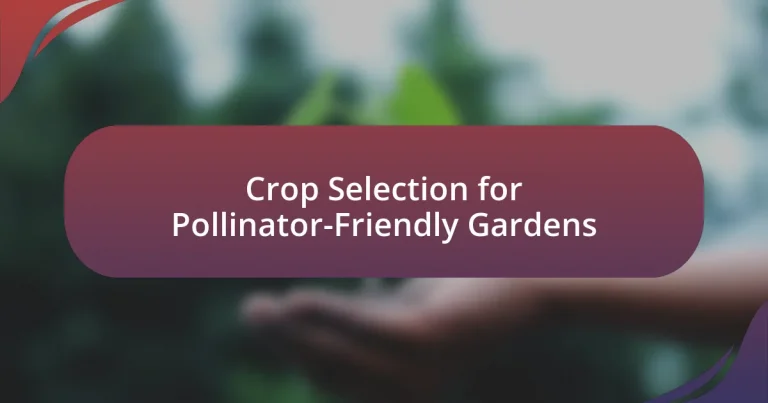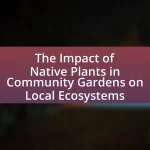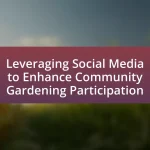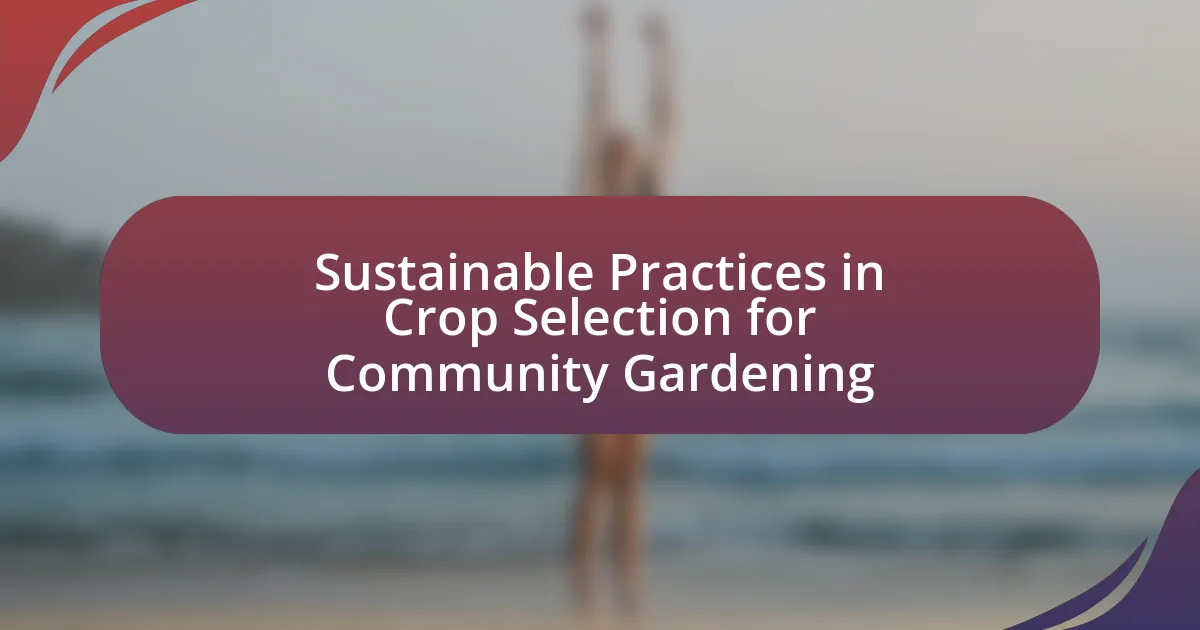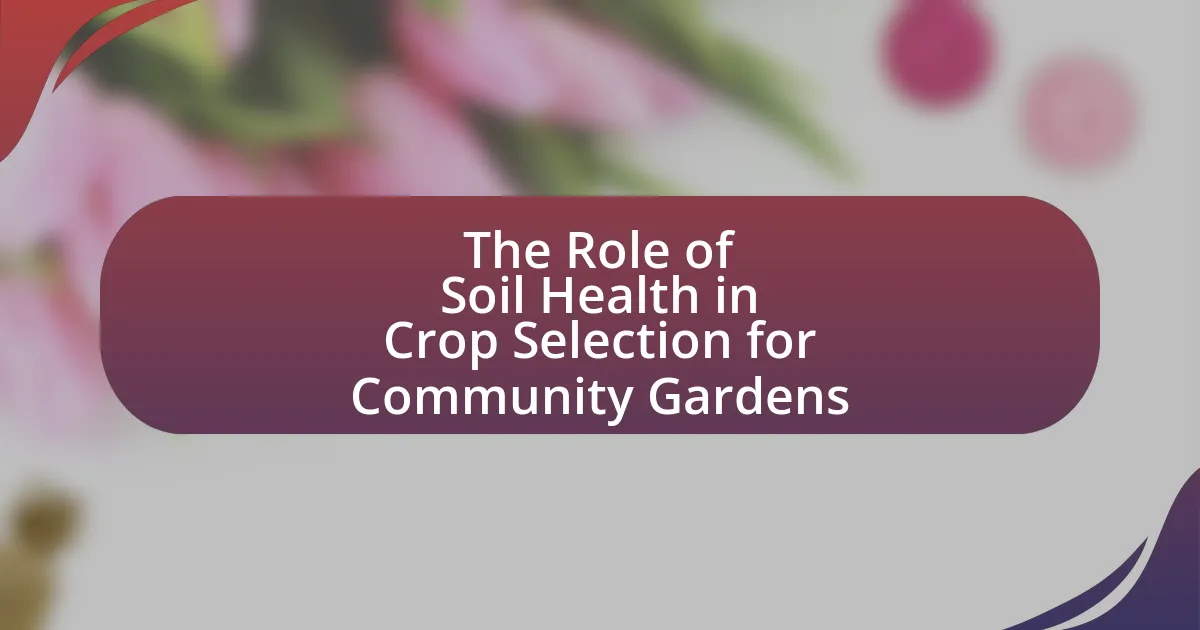Crop selection for pollinator-friendly gardens is the practice of choosing plants that attract and support pollinators such as bees and butterflies. This selection is vital for providing essential nectar and pollen resources, which are crucial for the survival of these species. The article discusses the importance of diverse flowering plants, particularly native species, in enhancing pollinator populations and biodiversity. It also outlines key principles for selecting crops, the role of pollinators in garden ecosystems, challenges in crop selection, and best practices for maintaining a pollinator-friendly garden. Additionally, it highlights resources available for gardeners to effectively choose suitable plants and strategies to ensure a continuous bloom throughout the growing season.

What is Crop Selection for Pollinator-Friendly Gardens?
Crop selection for pollinator-friendly gardens involves choosing plants that attract and support pollinators such as bees, butterflies, and other beneficial insects. This selection is crucial because diverse flowering plants provide essential nectar and pollen resources, which are vital for the survival of these species. Research indicates that gardens with a variety of native flowering plants can increase pollinator populations and enhance biodiversity. For example, studies show that native plants are more effective at attracting local pollinators compared to non-native species, as they have co-evolved with these insects and provide the specific resources they need.
Why is crop selection important for pollinator-friendly gardens?
Crop selection is crucial for pollinator-friendly gardens because it directly influences the availability of food resources for pollinators. Choosing a diverse range of flowering plants that bloom at different times throughout the growing season ensures a continuous supply of nectar and pollen, which is essential for the health and survival of pollinator species such as bees and butterflies. Research indicates that gardens with a variety of native plants attract more pollinators and support greater biodiversity, as native plants are often better adapted to local ecosystems and provide the specific resources that local pollinators require.
What role do pollinators play in garden ecosystems?
Pollinators are essential for the reproduction of many plants in garden ecosystems, as they facilitate the transfer of pollen from male to female flower parts. This process increases plant diversity and productivity, leading to healthier ecosystems. For instance, studies show that approximately 75% of flowering plants depend on animal pollinators, including bees, butterflies, and birds, to produce fruits and seeds. This reliance on pollinators not only supports plant life but also enhances food production for humans and wildlife, demonstrating their critical role in maintaining ecological balance.
How does crop selection impact pollinator health and diversity?
Crop selection significantly impacts pollinator health and diversity by determining the availability of food resources and habitat. Diverse crops that include a variety of flowering plants provide essential nectar and pollen, which are crucial for the survival and reproduction of pollinators such as bees and butterflies. Research indicates that agricultural landscapes with a higher diversity of flowering crops support greater pollinator populations and enhance their foraging efficiency. For instance, a study published in the journal “Ecological Applications” found that farms with diverse crop rotations had 50% more bee species compared to monoculture systems. This evidence underscores the importance of selecting a range of crops to promote a healthy and diverse pollinator community.
What are the key principles of selecting crops for pollinators?
The key principles of selecting crops for pollinators include choosing diverse flowering plants, selecting native species, ensuring continuous bloom throughout the growing season, and providing a variety of flower shapes and sizes. Diverse flowering plants attract a wider range of pollinators, while native species are adapted to local ecosystems and support native pollinator populations. Continuous bloom ensures that pollinators have food sources available from early spring to late fall. Additionally, varying flower shapes and sizes cater to different pollinator species, enhancing overall pollinator health and biodiversity. These principles are supported by research indicating that diverse and native plantings significantly increase pollinator visitation rates and overall ecosystem health.
How do native plants influence pollinator attraction?
Native plants significantly enhance pollinator attraction by providing specific food sources and habitats that are adapted to local pollinator species. These plants typically produce nectar and pollen that are more suited to the preferences of native pollinators, such as bees, butterflies, and hummingbirds. Research indicates that gardens with a higher diversity of native flowering plants can attract up to four times more pollinators compared to non-native gardens. This is due to the co-evolution of native plants and pollinators, which has led to mutual adaptations that optimize foraging efficiency and reproductive success.
What characteristics should pollinator-friendly crops possess?
Pollinator-friendly crops should possess characteristics such as diverse flowering times, high nectar and pollen production, and native plant compatibility. Diverse flowering times ensure that blooms are available throughout the growing season, providing continuous food sources for pollinators. High nectar and pollen production is crucial as it attracts a variety of pollinators, including bees and butterflies, which are essential for crop pollination. Additionally, native plants are adapted to local ecosystems and are more likely to support native pollinator species, enhancing biodiversity and ecosystem health. Research indicates that incorporating these characteristics can significantly increase pollinator visitation rates, thereby improving crop yields and overall garden productivity.
What challenges exist in crop selection for pollinator-friendly gardens?
Challenges in crop selection for pollinator-friendly gardens include the need for diverse plant species, the timing of flowering periods, and the suitability of plants to local environmental conditions. Diverse plant species are essential to attract various pollinators, but selecting the right mix can be complex due to differing habitat requirements. Additionally, ensuring that flowering periods align with the active seasons of pollinators is crucial; for instance, some plants may bloom too early or too late, limiting their effectiveness. Furthermore, local environmental conditions, such as soil type and climate, can restrict the viability of certain crops, making it necessary to choose plants that are well-adapted to the specific region. These factors complicate the decision-making process for gardeners aiming to create effective pollinator-friendly spaces.
How do environmental factors affect crop selection?
Environmental factors significantly influence crop selection by determining the suitability of specific plants for growth in a given area. Factors such as soil type, climate, water availability, and local biodiversity directly affect which crops can thrive. For instance, crops like corn and soybeans require well-drained, fertile soil and specific temperature ranges, while drought-resistant plants like millet are selected in arid regions. Additionally, the presence of pollinators, which are essential for many crops, can be influenced by environmental conditions such as habitat availability and pesticide use. Research indicates that diverse plantings can enhance pollinator populations, thereby improving crop yields and ecosystem health.
What common misconceptions exist about pollinator-friendly crops?
Common misconceptions about pollinator-friendly crops include the belief that all flowering plants are beneficial for pollinators and that native plants are the only option for supporting them. In reality, while many flowering plants can attract pollinators, not all provide the necessary resources such as nectar and pollen. Additionally, non-native plants can also be effective in supporting pollinator populations if they are chosen carefully. Research indicates that a diverse selection of both native and non-native plants can enhance pollinator habitats, as demonstrated in studies showing increased pollinator visits to gardens with varied plant species.
How can gardeners effectively choose crops for pollinator-friendly gardens?
Gardeners can effectively choose crops for pollinator-friendly gardens by selecting native flowering plants that provide nectar and pollen throughout the growing season. Research indicates that native plants are more attractive to local pollinators, such as bees and butterflies, due to their co-evolution with these species. For example, a study published in the journal “Ecological Applications” found that gardens with a higher diversity of native plants supported greater pollinator abundance and diversity. Additionally, incorporating a mix of annuals and perennials can ensure continuous bloom, further supporting pollinator populations.
What resources are available for selecting the right crops?
Resources available for selecting the right crops include agricultural extension services, online databases, and local agricultural organizations. Agricultural extension services provide expert advice tailored to specific regions, helping farmers choose crops that thrive in local conditions. Online databases, such as the USDA Plant Hardiness Zone Map, offer information on climate suitability for various crops. Local agricultural organizations often conduct workshops and provide resources that focus on pollinator-friendly plants, ensuring that selected crops support local ecosystems. These resources collectively enhance informed decision-making for crop selection in pollinator-friendly gardens.
How can local extension services assist in crop selection?
Local extension services assist in crop selection by providing research-based recommendations tailored to local environmental conditions and agricultural practices. These services analyze soil types, climate, and pest pressures to suggest the most suitable crops for specific regions, ensuring that farmers choose plants that thrive and support local pollinator populations. For example, studies have shown that crops like native wildflowers and specific fruit varieties can enhance biodiversity and attract beneficial insects, which local extension agents can recommend based on regional data.
What online tools can help identify suitable plants for pollinators?
Online tools that can help identify suitable plants for pollinators include the Pollinator Partnership’s Plant Database, which provides a comprehensive list of native plants beneficial to pollinators based on geographic location. Additionally, the Xerces Society offers an online tool called the Pollinator Plant List, which categorizes plants by their attractiveness to various pollinator species. These resources are validated by research indicating that native plants significantly enhance pollinator habitats, thereby supporting biodiversity and ecosystem health.
What are the best practices for maintaining a pollinator-friendly garden?
To maintain a pollinator-friendly garden, select a diverse range of native flowering plants that bloom at different times throughout the growing season. This diversity ensures a continuous food source for pollinators such as bees, butterflies, and hummingbirds. Research indicates that native plants are more beneficial for local pollinator populations, as they have co-evolved with these species and provide the necessary nectar and pollen. Additionally, avoid using pesticides, particularly during blooming periods, as they can harm pollinators. Implementing practices such as providing water sources and creating habitats with shelter, like brush piles or native grasses, further supports pollinator health and activity.
How can gardeners create a year-round bloom for pollinators?
Gardeners can create a year-round bloom for pollinators by selecting a diverse range of flowering plants that bloom at different times throughout the seasons. This approach ensures that pollinators have access to food sources from early spring to late fall. For instance, planting early bloomers like crocuses and snowdrops can provide nectar in spring, while summer flowers such as coneflowers and bee balm can sustain pollinators during warmer months. Additionally, incorporating late bloomers like asters and goldenrods can extend the blooming period into autumn. Research indicates that gardens with a variety of flowering plants can support a higher diversity of pollinator species, as different species have varying preferences for specific flowers and bloom times.
What maintenance strategies support the health of pollinator-friendly crops?
Maintenance strategies that support the health of pollinator-friendly crops include implementing diverse planting, minimizing pesticide use, and ensuring consistent water availability. Diverse planting attracts a variety of pollinators, enhancing crop productivity and ecosystem resilience. Research indicates that fields with a mix of flowering plants can increase pollinator visitation rates by up to 50%. Minimizing pesticide use is crucial, as studies show that neonicotinoids can reduce bee populations by over 30%, negatively impacting pollination services. Additionally, maintaining consistent water availability through irrigation or mulching helps sustain plant health and supports pollinator activity, as water is essential for both crop and pollinator survival.
What tips can enhance the success of a pollinator-friendly garden?
To enhance the success of a pollinator-friendly garden, select a diverse range of native flowering plants that bloom at different times throughout the growing season. This diversity ensures that pollinators have a continuous food source, which is crucial for their survival and reproduction. Research indicates that gardens with a variety of native plants can attract up to four times more pollinators compared to those with non-native species. Additionally, avoid using pesticides, as they can harm beneficial insects; studies show that even low levels of certain pesticides can significantly reduce pollinator populations. Providing habitats such as nesting sites and water sources further supports pollinator health and activity.
